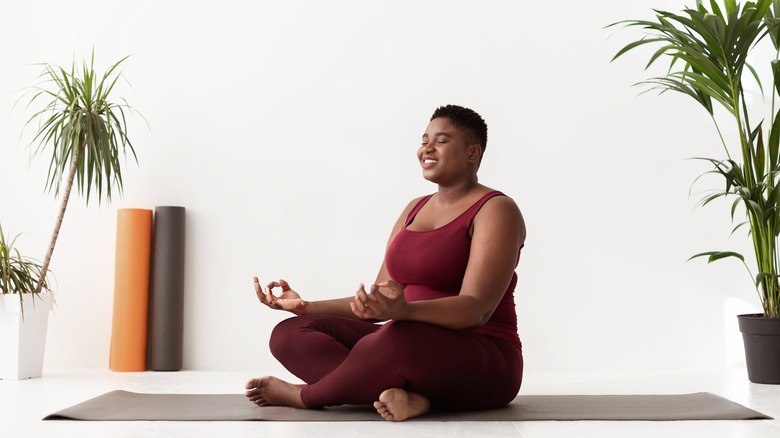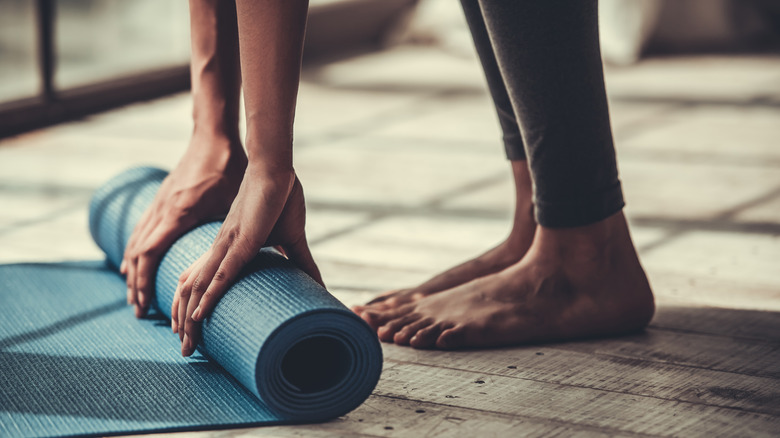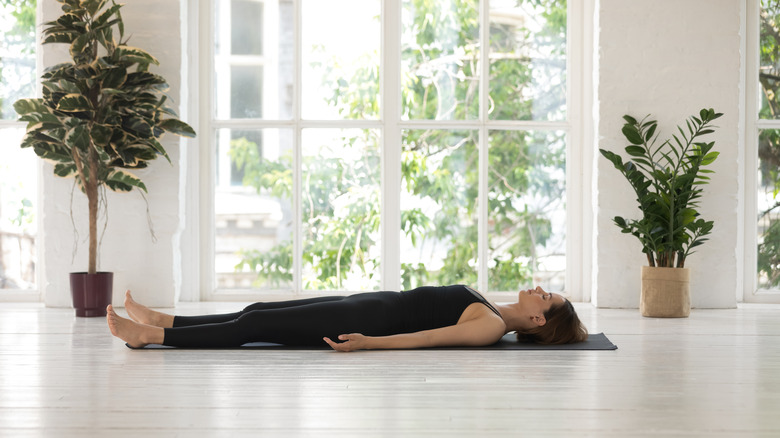The Best Yoga Poses To Try To Help Irregular Periods
Irregular periods can happen for a number of reasons ranging from lifestyle factors to more serious health conditions. According to Cleveland Clinic, abnormal periods are often caused by stress, lifestyle, birth control pills, endometriosis, polycystic ovary syndrome (PCOS), pelvic inflammatory disease, uterine fibroids, and in rare cases, uterine or cervical cancer. While irregular periods stem from different reasons, there are many at-home treatments that may help support your flow. Some home remedies include adding ginger to your diet, exercising regularly, maintaining a healthy weight, and eating pineapples (per Healthline). But the number one at-home remedy Healthline recommends for irregular periods is yoga.
One 2017 study examined how yoga practice affects physical fitness, menstrual pain, and quality of life in inactive women with primary dysmenorrhea. During the study, researchers studied 34 women between the ages of 18 to 22 years old for 12 weeks. By the end of the 12 weeks, the women who followed the yoga program saw an improvement in all areas — physical fitness, menstrual pain, and quality of life — when compared to the control group.
That being said, contorting into uncomfortable positions is probably the last thing on your radar during irregular menstruations. Fortunately, the best type of yoga for irregular periods is all about intense relaxation (via Women's Health). So whether you're familiar with yoga or stepping onto the yoga mat for the first time, here's the best yoga pose (and practice) to try to help irregular periods.
Try cultivating a yoga nidra practice
One randomized study published in the Journal of Alternative and Complementary Medicine explains that cultivating a yoga nidra practice can be helpful for participants who have menstrual irregularities. In particular, the researchers found it can be helpful for hormonal imbalances like metrorrhagia, oligomenorrhea, dysmenorrhea, hypomenorrhea, and menorrhagia. These results are based on participants practicing yoga nidra for 35 to 40 minutes per day, 5 days a week for 6 months.
A different study published in the Indian Journal of Physiology and Pharmacology reports that yoga nidra may also positively affect physiological variables in women with irregular periods. Researchers found that after 6 months of regular yoga practice, postural hypotension, blood pressure, sustained hand grip, and heart rate all improved substantially.
What's even more impressive about yoga nidra is that it may help other problems that stem from irregular periods. According to a 2016 study, this type of yoga (in combination with medication) may help treat psychological issues that women with menstrual disorders sometimes face. The researchers point out that after 6 months, the scores on all assessments — positive well-being, anxiety, vitality, depression, overall health, and hormone levels — significantly increased when compared to the initial test. With this in mind, some of the best yoga poses for irregular periods aren't about the poses themselves, but rather, about the type of yoga being performed.
The best yoga nidra pose to try
When it comes to cultivating your own yoga nidra practice, it's important to focus on relaxation. Why? Because the relaxation causes the breath to slow and triggers your brain to create more delta waves just like it does in deep sleep, points out Women's Health. This in turn can affect certain hormone levels that affect menstruation. The Journal of Alternative and Complementary Medicine explains that deep relaxation can significantly drop thyroid-stimulating, follicle-stimulating, and luteinizing hormones, as well as prolactin.
Unlike other yoga practices that focus on various seated or standing poses to strengthen the body, yoga instructor Rod Stryker tells Yoga Journal that a yoga nidra practice focuses on engaging the muscles of surrender. Its goal is to help you reach the deepest level of relaxation you can find, Stryker further explains. Yoga Journal explains that this practice can be as short as ten minutes, focusing on stages instead of poses. Some of these stages include setting intentions, focusing on your breath, and placing your awareness on any sensations, emotions, and thoughts (per Yoga Journal). In other words, it's all about tuning into your body and listening to its ebbs and flow.
If you're still looking for a specific yoga pose to practice, consider trying corpse pose (also known as savasana). The entire yoga nidra practice is traditionally completed in just corpse pose alone. While yoga can be helpful, it's important to talk with your doctor if you're concerned about your menstruation irregularities.



